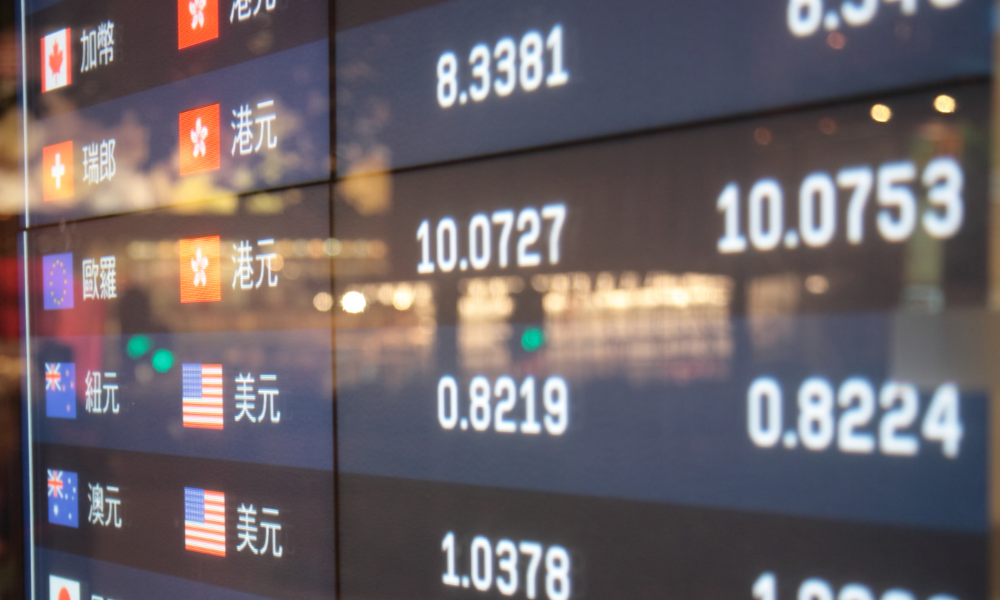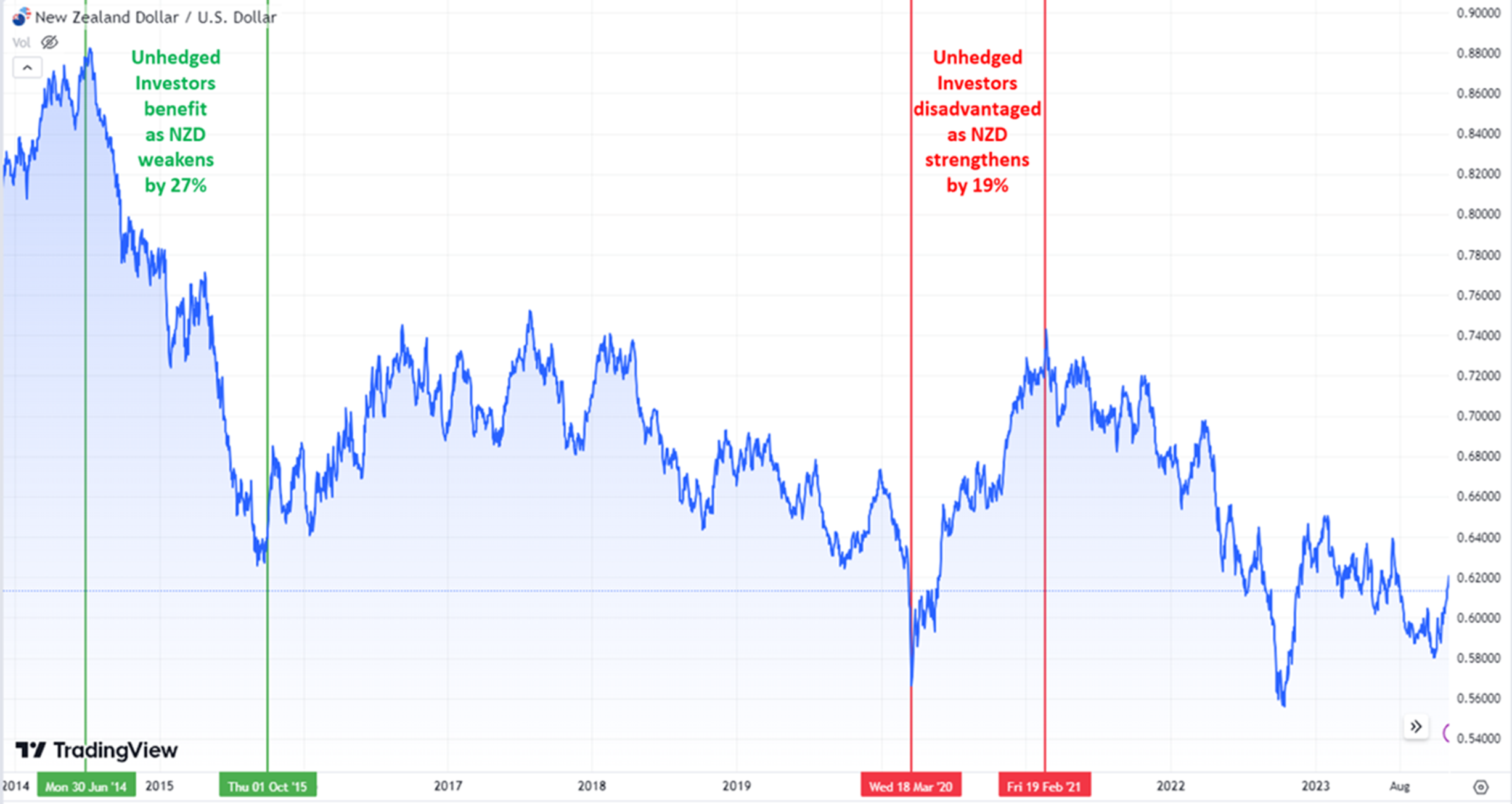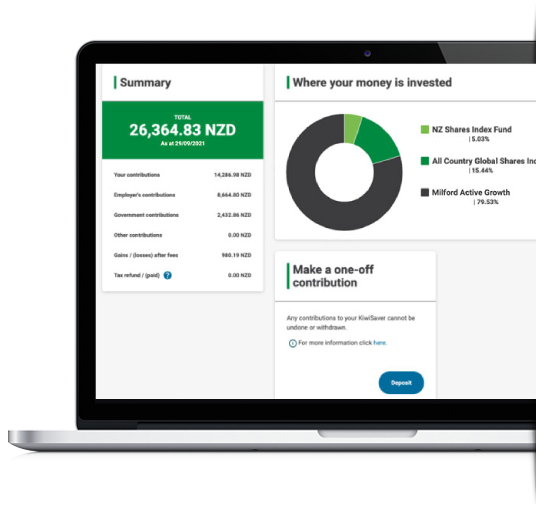
The InvestNow Guide To Currency Hedging: The Impact of Foreign Currency on Investments
Article written by InvestNow – 1st February 2024
Whenever you invest into overseas assets, the value of those assets in New Zealand dollar terms is influenced by the combined impact of:
- Price movements in the underlying investment; and
- Currency movements between the New Zealand dollar (NZD) and foreign currency that the underlying investment is denominated in.
As a Kiwi investor, assets are typically valued in NZ dollar terms, as that is the local currency we transact in. However, overseas assets are not denominated in NZ dollars. This means that the rise and fall in the value of the NZD against other foreign currencies can impact the value of your overseas investments and overall returns when translated back to NZ dollar terms.
For example, if a NZD-denominated fund invests into a USD-based investment (such as Foundation Series US 500 Fund) and that underlying offshore investment increases in value by 10%, but the value of the USD relative to the NZD also falls by 2%, then the overall change in value of the fund in NZD-terms is roughly 8% (made up of a +10% underlying investment return plus a -2% currency return).
This is why the value of some NZD-denominated funds that invest into offshore assets can still go up or down, even when the value of the underlying investment (in foreign currency terms) hasn’t changed at all.
Currency Hedging Explained
Currency hedging can be applied to investments in order to mitigate the impact of currency fluctuations on the value of the investments, guarding against foreign exchange movements.
In very simple terms, it aims to protect investors against the impact of changing foreign exchange rates on their investment.
A fund’s ‘hedge ratio’ will determine the extent of the fund’s exposure to currency movements:
- A fully hedged fund (hedge ratio of 100%) will target a return in NZD terms that is in-line with the underlying investment (i.e. neutralises currency movements); while
- An unhedged fund (hedge ratio of 0%) will be fully exposed to the underlying currency fluctuations, alongside any movements in the underlying assets.
Using the same example above, if you invested into a fully hedged version of an NZD-denominated fund that invests into underlying USD-based assets (such as the Foundation Series Hedged US 500 Fund) and the offshore assets go up by 10%, then the fund would also achieve an approximate return of 10% in NZD-terms. This is achieved irrespective of any changes in the NZD/USD exchange rate, due to the impact of hedging.
Most funds have a hedge ratios of less than 100% (i.e. they are either fully or partially exposed to the impact of currency fluctuations). However, a sizable number of funds on InvestNow are available fully hedged to the NZ dollar. You can easily identify these hedged funds on InvestNow as they will more often than not have the word “Hedged” in their name, for example:
- Foundation Series Hedged Total World Fund
- Harbour T. Rowe Price Global Equity Fund (Hedged)
- Mercer Core Hedged Global Shares Fund
- Vanguard International Shares Select Exclusions Index Fund – Hedged (NZD Class)
The Ups and Downs
Movements in currencies can have positive or negative impacts on your portfolio. Sticking with the NZD/USD exchange rate as an example and assuming you were invested in an unhedged fund:
- If the NZD becomes weaker against the USD, your investment will be worth more in NZD-terms as you’d receive more NZD if you sold those USD-denominated assets;
- If the NZD becomes stronger against the USD, your investment will be worth less in NZD-terms, as you’d receive less NZD if you sold those USD-denominated assets.

The additional volatility of currency movements isn’t for everyone though, as the impact of currency movements can be quite significant.
For example, the roughly 1-year period from March 2020 to February 2021 saw the NZD strengthen nearly 20% versus the USD. For an unhedged investor, this acts as a drag on the overall fund return by roughly 20%, meaning that even if the underlying offshore investment went up by around 20%, your overall fund returns in NZD-terms would still be roughly unchanged over this period.
Conversely, currency movements can also bolster returns materially, as it had done in the period June 2014 to October 2015, when the weakening NZD padded fund returns by approximately another 27%.
The key takeaway is that currency fluctuations present an additional driver of returns above and beyond the change in value of the underlying offshore assets invested in. Having another factor impacting your returns can increase the volatility (risk) of your investment, which can be quite significant.
Hedging is specifically designed to address this aspect of the volatility (risk) in your investment.
Is there an additional cost to hedging?
In many instances a fund manager will charge a higher management fee to cover the extra costs they incur to include a solution to hedge the currency. This reflects the fact that the fund manager has entered into some form of foreign exchange arrangement where another party is guaranteeing a future exchange rate, most often a bank – a service they charge for.
Some managers maintain the same management fee charges for both the hedged and unhedged version of the funds, such as for the Foundation Series Funds.
Any additional cost for hedging is akin to an insurance premium i.e. it’s what you have to pay to reduce the risk. The question for you is, are you happy to pay this bit extra to reduce the impact of currency risk in your investment?
Below are examples of hedged and unhedged international equities funds available on InvestNow, with their respective management fees.
Fund Name |
Management Fee % p.a. |
| Foundation Series US 500 Fund* | 0.03% |
| Foundation Series Hedged US 500 Fund* | 0.03% |
| Foundation Series Total World Fund* | 0.07% |
| Foundation Series Hedged Total World Fund* | 0.07% |
| Vanguard International Shares Select Exclusions Index Fund | 0.20% |
| Vanguard International Shares Select Exclusions Index Fund – Hedged (NZD Class) | 0.26% |
| Russell Investments Sustainable Global Shares Fund | 0.32% |
| Russell Investments Sustainable Hedged Global Shares Fund | 0.34% |
| Russell Investments Global Shares Fund | 0.89% |
| Russell Investments Hedged Global Shares Fund | 0.92% |
| Nikko AM Global Shares Fund | 1.20% |
| Nikko AM Global Shares Hedged Fund | 1.20% |
| Harbour T. Rowe Price Global Equity Fund | 1.20% |
| Harbour T. Rowe Price Global Equity Fund (Hedged) | 1.23% |
* The Foundation Series US 500 and Total World Funds and the Foundation Series Hedged US 500 and Hedged Total World Funds are subject to a transaction fee charge of 0.50% for all Buy Orders (Entry Fee) and 0.50% for all Sell Orders (Exit Fee).
To Hedge or Not to Hedge:
Ultimately the decision to invest into solutions that are fully hedged, completely unhedged, or something in between will depend on the need for which you are investing, and how you want your investments to behave/perform relative to your goal and/or investment objective.
Applying a hedging approach based on the investment goal or objective is prudent as hedging can be more appropriate for some asset classes than others. This is the reason why fund managers in New Zealand almost always fully hedge their global bond exposure, as the goal of fixed income investing is capital preservation. Whereas introducing currency exposure would add a layer of volatility that can potentially undermine the defensive nature of bonds.
If you are wanting to minimise the performance and/or income volatility (risk) in your offshore investments, to target exposure to only the movements of the underlying assets of the fund, then including hedged investments in your portfolio is something to consider.
There are also valid reasons to go unhedged, including to avoid any additional costs of hedging, or making a conscious decision to have more foreign currency exposure to act as a portfolio diversifier, or a belief that long-term currency fluctuations will even out over time.
An approach in between is also equally valid, with many fund managers taking a 50% hedged approach to global shares. This recognises the validity of both sides of the hedging debate by allocating the risk and benefits of currency exposure equally on either end of the spectrum. This can be achieved by investing equal parts in both a fully hedged fund and a fully unhedged fund, or investing into a single fund that employs a partially hedged strategy.
To summarise…
Overall, foreign currency movements are incredibly hard to predict – even professional investment managers can get it wrong. Accordingly, it may be prudent to avoid picking a hedging strategy based on what you think will perform best, but rather one based on whether it suits your investment goals and constraints.
Whether this is going fully hedged, unhedged or something in between, many investors have historically done well picking a hedging strategy and sticking to it. While it may be tempting to try and change hedging strategies based on market movements, similar to trying to time the market, constantly switching hedging approaches to try and chase performance can be a dangerous game that very few investors win.
InvestNow has a wide range of hedged, unhedged or partially hedged funds to suit most investment approaches. You can customise your hedging strategy to suit your own investment goals by allocating proportionately to a hedged and unhedged version of a fund. Equally you can simplify things by investing in a single fund that already employs the hedging strategy you are after.
To implement your preferred hedging strategy, see here for InvestNow’s full range of funds

Other hedged fund options available on InvestNow
We have a range of hedged fund options available on InvestNow. An easy way to spot them is to look for the word ‘hedged’ in the name of the fund, or refer to the fund information in each fund’s Product Disclosure Statement (PDS). Click here to see the full range of funds.
